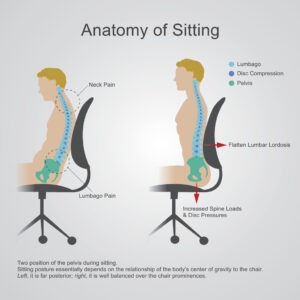Ergonomic Seating for Spine Health Benefits
 In our modern sedentary lifestyles, many of us spend long hours sitting, whether it be at our desks, in front of the computer, or during leisure activities. Prolonged sitting can have detrimental effects on our spinal health, leading to discomfort, pain, and long-term musculoskeletal issues. However, by utilizing seats that fit the body, we can significantly improve our spinal health and overall well-being. This essay delves into the benefits for spine health and the features that make these seat solutions effective.
In our modern sedentary lifestyles, many of us spend long hours sitting, whether it be at our desks, in front of the computer, or during leisure activities. Prolonged sitting can have detrimental effects on our spinal health, leading to discomfort, pain, and long-term musculoskeletal issues. However, by utilizing seats that fit the body, we can significantly improve our spinal health and overall well-being. This essay delves into the benefits for spine health and the features that make these seat solutions effective.
Ergonomic seating refers to systems that are designed to provide optimal support and promote healthy posture while minimizing strain on the spine. These solutions for seats take into account the natural curvature of the spine and offer adjustable features to accommodate individual body types and preferences. By reducing stress with proper alignment on the spinal structures, seating that algns to your body can alleviate pain and discomfort associated with prolonged sitting.
One of the key benefits of comfortable chairs is its ability to promote good posture. Traditional chairs often lack the necessary lumbar support, leading to slouching and poor spinal alignment. Ergonomic chairs, on the other hand, feature adjustable lumbar support that conforms to the natural curve of the lower back. This support helps maintain the spine’s neutral position, reducing the strain on the intervertebral discs and muscles of the lower back. By keeping the spine properly aligned, seats align with your body can help prevent conditions such as lower back pain and disc herniation.
Another essential feature of ergonomic seating is adjustable seat height. Having the ability to adjust the seat height allows individuals to position their feet flat on the floor, promoting proper blood circulation and reducing pressure on the thighs and hips. This feature also ensures that the knees are bent at a comfortable 90-degree angle, preventing strain on the lower back and promoting a neutral spine.
 Comfortable chairs often incorporate adjustable armrests, which provide support for the arms and shoulders, reducing tension in the upper body. Adjustable armrests allow users to position their arms at a comfortable height, keeping the shoulders relaxed and preventing excessive pressure on the upper muscles. Individuals who for extended periods work at a computer or performing tasks that require arm and shoulder engagement benefit from this feature.
Comfortable chairs often incorporate adjustable armrests, which provide support for the arms and shoulders, reducing tension in the upper body. Adjustable armrests allow users to position their arms at a comfortable height, keeping the shoulders relaxed and preventing excessive pressure on the upper muscles. Individuals who for extended periods work at a computer or performing tasks that require arm and shoulder engagement benefit from this feature.
Furthermore, seating body fitting solutions often incorporate materials that offer adequate cushioning and breathability. High-quality foam or mesh upholstery provides comfort while allowing air circulation, reducing the risk of heat buildup and sweating. These features promote a more comfortable sitting experience and minimize the likelihood of discomfort and pain associated with prolonged sitting.
It is important to note that while seats that fit your body offer numerous benefits for spine health, it should be complemented with regular breaks, stretching exercises, and overall movement throughout the day. Incorporating short breaks to stand, stretch, and walk can help reduce the strain on the spine and prevent the negative effects of prolonged sitting.
In conclusion, ergonomic seating is a valuable investment for individuals seeking to prioritize their spinal health and overall well-being. By providing optimal support, promoting good posture, and reducing strain on the spine, chairs that fit your body contribute to a more comfortable and healthier sitting experience. The adjustable features, lumbar support, and cushioning work in tandem to alleviate discomfort, prevent spinal issues, and enhance overall productivity. By combining regular movement and postural awareness, individuals can take proactive steps towards maintaining a healthy spine and mitigating the negative effects of prolonged sitting in today’s sedentary lifestyle.






